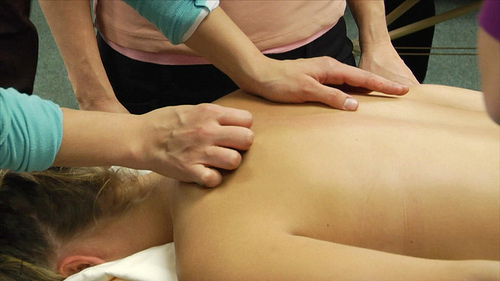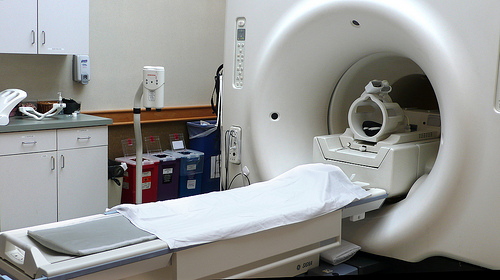There will be a time, when the 90% of people will suffer from ailments coming from the spine. This could be revealed through cervicalgia, pain in the area of blade-bone, low back or in certain cases of radiation. Considering human anatomy and how innervated we are, a pain may radiate in strongly specified way, depending on what sort of structure is injured. In the event of a nerve compression, cervical segment can radiate in the form of pain, lancinating pain, stiffness or upper limb paraesthesia. One should remember that we can suffer from headaches or cervical vertigo, but in this case, an additional consultation with a neurologist and laryngologist is required to exclude other causes. Thoracic segment can give a wrapping pain to the ribs and, sometimes, speak in the form of retrosternal pain, enhanced during deep inhalation. Occasionally, such people go to hospital with a surmise of heart attack! Obviously, such symptoms cannot be belittled. It is therefore advisable to make a follow-up visit. Talking about lumbar segment, the symptoms can invade the lower part of the back, buttocks and lower limbs. Generally, the signs originating from the spine can have different characteristics, such as: pain, stiffness, increased tonicity and limitation of certain movements. With the involvement of neural structure, there can be also paraesthesia, stiffness, burning sensations, etc. In such cases, it is important to examine the neural conductivity. This means that the evaluation of tendon reflexes and assessment of power will be needed.
Considering human anatomy and how innervated we are, a pain may radiate in strongly specified way, depending on what sort of structure is injured. In the event of a nerve compression, cervical segment can radiate in the form of pain, lancinating pain, stiffness or upper limb paraesthesia. One should remember that we can suffer from headaches or cervical vertigo, but in this case, an additional consultation with a neurologist and laryngologist is required to exclude other causes. Thoracic segment can give a wrapping pain to the ribs and, sometimes, speak in the form of retrosternal pain, enhanced during deep inhalation. Occasionally, such people go to hospital with a surmise of heart attack! Obviously, such symptoms cannot be belittled. It is therefore advisable to make a follow-up visit. Talking about lumbar segment, the symptoms can invade the lower part of the back, buttocks and lower limbs. Generally, the signs originating from the spine can have different characteristics, such as: pain, stiffness, increased tonicity and limitation of certain movements. With the involvement of neural structure, there can be also paraesthesia, stiffness, burning sensations, etc. In such cases, it is important to examine the neural conductivity. This means that the evaluation of tendon reflexes and assessment of power will be needed.
Does the diagnosis has to begin with additional examinations, such as X-ray, magnetic resonance or CT scan?
In the vast majority of cases it hasn`t, unless the cause of complaint was an injury or accident. Professional clinician is able to make an assessment through a detailed interview and performance of neurological and functional examination, including mobility testing. In case of appearance of any distressing symptoms or considerable neurological deficits during the examination performance, it is necessary to write a hospital referral form to an additional test, for example resonance and consultation with neurologist, neurosurgeon or orthopedic surgeon.
When is the surgery necessary?
When the symptoms of spinal cord compression appear, that is myelopathy, radiculopathy, commonly known as compression of the nerve root causing paralysis and muscle inertia. In the case of the so-called cauda equine, the spinal cord is situated in the vertebral canal, extending from the head to the L2 level, below which the cauda equina extends - the nerve bundle – which, in the event of pressure, may cause paresthesia and numbness around the crotch and bladder dysfunction, e.g. urinary incontinence. In the vast majority, the cases are not as shocking as described above. Most frequently, patients notify significant pain ailments with or without neurological symptoms that impede normal functioning.
What is the cause of the ailments?

In almost 90% of cases, an intervertebral disc damage (discitis) is the cause. Modern society suffers from more and more ailments aroused from overloaded spine. The biggest enemies of the spine`s are mainly: decreased physical activity, seating lifestyle, obesity and prolonged stress. Each and every man is in the know that pain can appear after carrying heavy things. It seems true, that the considerable amount of patients leads a seating lifestyle and the symptoms could occur progressively, and not the moment after carrying heavy bags.
Could muscles be the cause?
It is unusual for muscles to be considered as a primary cause of ailments. Are they tensed up? Yes, they are because they react instinctively to strain but it is not the reason why it hurts. This leads us to a very important conclusion that massage alone cannot be the core of the treatment. In some cases, a neck tension and a neck pain will be noticeable after the massage, but will the treatment be effective? Probably not, because after a short period of time, the neck is tight again since we have reacted to the effect, not to the cause. In that case, a massage would be one of the components of the therapy, however, equally important would be work on the mobility of the thoracic spine and muscle training responsible for the stabilization cervical segment. Moreover, it is important to understand that physiotherapy is a complex operation involving examination, treatment through various techniques of manual therapy and doing exercises at home. An integral part is education concerning ergonomics in everyday life. Physiotherapist would not be able to fix the discitis, due to lack of blood supply. However, with an appropriate methodical treatment, the pain can be reduced and improve a motion range. As a result, one will be able to function normally again. Another important aspect is the patient`s involvement in both the healing process and the understanding of the nature of the ongoing ailments.









